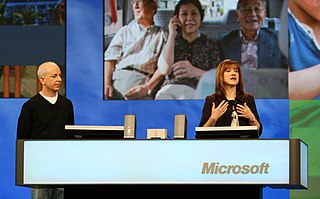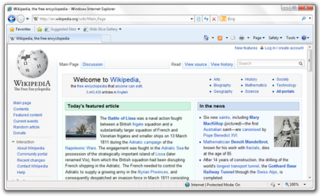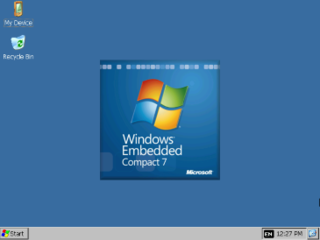JScript is Microsoft's legacy dialect of the ECMAScript standard that is used in Microsoft's Internet Explorer web browser.
Extensible Application Markup Language is a declarative XML-based language developed by Microsoft for initializing structured values and objects. It is available under Microsoft's Open Specification Promise.
Trident is a proprietary browser engine for the Microsoft Windows version of Internet Explorer, developed by Microsoft.

Microsoft Blend for Visual Studio is a user interface design tool developed and sold by Microsoft for creating graphical interfaces for web and desktop applications that blend the features of these two types of applications. It is an interactive, WYSIWYG front-end for designing XAML-based interfaces for Windows Presentation Foundation, Silverlight and UWP applications. It was one of the applications in the Microsoft Expression Studio suite before that suite was discontinued.
Windows Presentation Foundation (WPF) is a free and open-source user interface framework for Windows-based desktop applications. WPF applications are based in .NET, and are primarily developed using C# and XAML.

Internet Explorer Mobile was a mobile version of Internet Explorer developed by Microsoft, based on versions of the MSHTML (Trident) layout engine. IE Mobile comes loaded by default with Windows Phone and Windows CE. Later versions of Internet Explorer Mobile are based on the desktop version of Internet Explorer. Older versions however, called Pocket Internet Explorer, are not based on the same layout engine.

Microsoft's Professional Developers Conference (PDC) was a series of conferences for software developers; the conference was held infrequently to coincide with beta releases of the Windows operating system, and showcased topics of interest to those developing hardware and software for the new version of Windows.

Live Connect is a collection of APIs and common controls that allow developers to have a deeper control and offers access to the core Windows Live services and data through open and easily accessible application programming interfaces (APIs). At MIX07, Microsoft's Senior Architect Danny Thorpe described:
[The Windows Live Platform] today can combine video, photos, contacts, maps, and search into web applications. Users can drop web controls into the web applications with just a few lines of JavaScript and be up and running in a matter of minutes, and they can dive a little deeper to access service APIs directly and define their own UI and process flow. Users have control over what applications can access their private data, and can revoke that access at any time.

Microsoft Silverlight is a discontinued application framework designed for writing and running rich internet applications, similar to Adobe's runtime, Adobe Flash. While early versions of Silverlight focused on streaming media, later versions supported multimedia, graphics, and animation, and gave support to developers for CLI languages and development tools. Silverlight was one of the two application development platforms for Windows Phone, but web pages using Silverlight did not run on the Windows Phone or Windows Mobile versions of Internet Explorer, as there was no Silverlight plugin for Internet Explorer on those platforms.

Windows Internet Explorer 8 (IE8) is a web browser for Windows. It was released by Microsoft on March 19, 2009.

Internet Explorer 9 or IE9 is the ninth major version of the Internet Explorer web browser for Windows. It was released by Microsoft on March 14, 2011, as the successor to Internet Explorer 8. Microsoft released Internet Explorer 9 as a major out-of-band version that was not tied to the release schedule of any particular version of Windows, unlike previous versions. It is the first version of Internet Explorer not to be bundled with a Windows operating system, although some OEMs have installed it with Windows on their PCs. Internet Explorer 9 was the last version to be called Windows Internet Explorer. The software was rebranded simply as Internet Explorer starting with the release of Internet Explorer 10.

Windows Phone (WP) is a discontinued mobile operating system developed by Microsoft for smartphones as the replacement successor to Windows Mobile and Zune. Windows Phone featured a new user interface derived from the Metro design language. Unlike Windows Mobile, it was primarily aimed at the consumer market rather than the enterprise market.

Deep Zoom is a technology developed by Microsoft for efficiently transmitting and viewing images. It allows users to pan around and zoom in on a large, high resolution image or a large collection of images. It reduces the time required for initial load by downloading only the region being viewed or only at the resolution it is displayed at. Subsequent regions are downloaded as the user pans to them; animations are used to hide any jerkiness in the transition. The libraries are also available in other platforms including Java and Flash.
XAML Browser Applications are Windows Presentation Foundation (.xbap) applications that were intended to run inside a web browser such as Firefox or Internet Explorer through the NPAPI interface. Due to NPAPI being phased out in recent years, and from lack of support, there are currently no browsers that support XBAP applications.
Microsoft Device Emulator is an emulator for Windows Mobile-based devices. Microsoft Officially launched an emulator for Windows Mobile 6.5 in November 2008, The Windows Mobile 6.5 Developer Tool Kit adds various features for developing such as documentation, obtaining a sample code, header and library files, emulator images and tools to Visual Studio. The Microsoft Device Emulator is available in Simplified Chinese, English, German, French, Italian, Spanish, and Japanese. Independent from the Windows Mobile emulator Microsoft has also released an emulator for Internet Explorer Mobile for developers.
Seadragon Software was a team within the Microsoft Live Labs. Its product, Seadragon, is a web optimized visualization technology that allows graphics and photos to be smoothly browsed, regardless of their size. Seadragon is the technology powering Microsoft's Silverlight, Pivot, Photosynth and the standalone cross-platform Seadragon application for iPhone and iPad.

Windows Embedded Compact 7 is the seventh major release of the Windows Embedded CE operating system, released on March 1, 2011. Windows Embedded Compact 7 is a real-time OS, separate from the Windows NT line, and is designed to target enterprise specific tools such as industrial controllers and consumer electronics devices such as digital cameras, GPS systems and also automotive infotainment systems. Windows Embedded Compact is designed to run on multiple CPU architectures and supports x86, SH and ARM.
Microsoft Silverlight is an application framework for writing and running rich web applications that was actively developed and marketed by Microsoft from 2007 to 2012. This is a technical overview of the platform's history.
Windows UI Library is a user interface API that is part of the Windows Runtime programming model that forms the backbone of Universal Windows Platform apps for the Windows 8, Windows 8.1, Windows 10 and Windows Phone 8.1 operating systems. It enables declaring user interfaces using Extensible Application Markup Language (XAML) technology.







